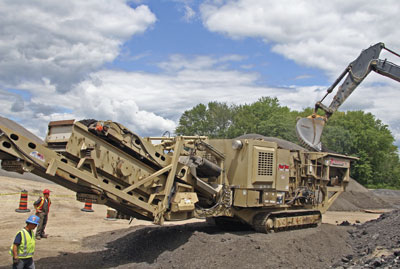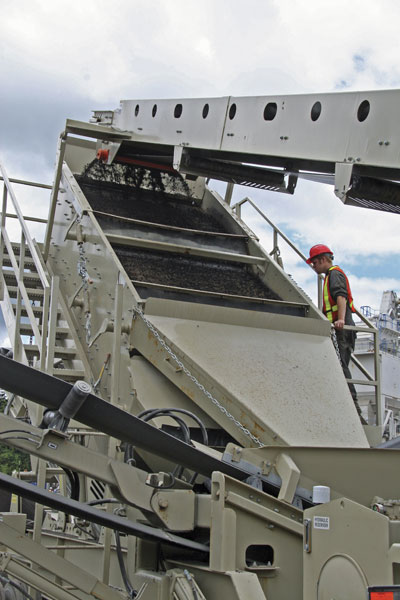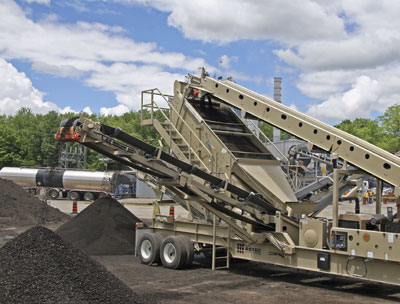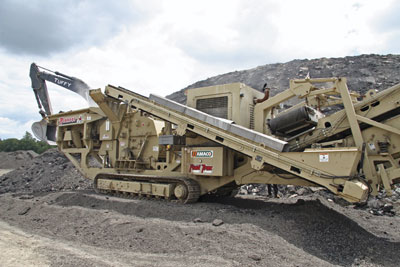
Features
Roads & Paving
Technology
RAP and fractionated RAP take off
More asphalt producers are using fractionated Reclaimed Asphalt Pavement
October 22, 2009 By Andy Bateman
Reclaimed Asphalt Pavement (RAP) has been used on a large scale by hot
mix asphalt producers since the 1970’s, spurred by sharp increases in
the price of oil and the availability of surface millings from
efficient cold milling machines.
Reclaimed Asphalt Pavement (RAP) has been used on a large scale by hot mix asphalt producers since the 1970’s, spurred by sharp increases in the price of oil and the availability of surface millings from efficient cold milling machines.

|
|
| The Andreas Series horizontal impact crusher on this KPI – JCI Pioneer FT4240 Fast Trax mobile processing plant reduced 600 mm minus broken asphalt to 16 mm minus. |
For many producers, however, the use of recycle material in new asphalt was limited by several factors, especially the segregation in “black crusher run” RAP feed material that caused unacceptable variation in the finished product. These limitations are rapidly disappearing as more producers separate RAP into multiple fractions to take full advantage of the recycle material. An equipment manufacturer is playing its part by offering RAP processing plants that meet tight gradation, capacity and portability requirements.
| RAP and fractionated RAP? RAP Fractionated RAP |
Aggregates & Roadbuilding saw one of these plants in action at a recent industry seminar showcasing the $105 million highway reconstruction project on Highway 401 near Woodstock, ON. (Aggregates & Roadbuilding July / August 2009). During the demonstration, a John Deere 450 D LC excavator maintained a steady feed of 600 mm minus broken asphalt to a KPI – JCI Pioneer FT4240 Fast Trax mobile processing plant. This plant’s Andreas Series horizontal impact crusher reduced all the feed material to 16mm minus, operating in closed circuit with an onboard 4 by 12 screen. The 16 mm minus material was then conveyed to an Astec Mobile Screens Fold ‘n Go 2612V mobile screening plant where it was separated into three fractions by a 6 by 12 two-deck, high-frequency PEP Vari–Vibe screen. The resulting stockpiles contained minus 16 mm plus 9.5 mm, minus 9.5 mm plus 4.8 mm, and minus 4.8 mm material. After fractionating, material drawn from these fractions was carried by wheel loader to three hot mix plant RAP feed bins as required.
One of the potential limitations of using RAP is its dust content, namely material passing the 0.075 mm sieve, due to the sensitivity of coarse asphalt mixes to even small changes in asphalt cement and dust content. Processed RAP will often contain more dust than the original recycled asphalt as a result of mechanical degradation from the milling and crushing processes. Users of the Vari-Vibe screen elsewhere have reported complete separation of minus 0.075 mm material in an asphalt sand screening application.
According to Astec Mobile Screens, the company’s PEP high-frequency screens provide the highest capacity in the market for applications such as fines removal, chip sizing and dry manufactured sand. Each screen is equipped with variable speed and screen angle operation for optimal efficiency when production needs change. PEP Vari-Vibe screens are available in single, double and triple deck configurations and range from 6' x 6' up to 6' x 24' depending on model. High-frequency screen action is available on all screen decks for processing material with separations typically ranging from 13 mm to 0.595 mm (595 microns). These screens are said to be ideal in post-screening applications where increased product output and reduced waste are the result of higher production capability and sizing efficiency compared to conventional screens. Higher production is achieved by an aggressive screen vibration directly applied to the screen media at rates up to 4200 RPM. This rapid screen vibration allows material to stratify and separate at a much faster rate than conventional screens. In addition, the rotary tensioning system utilized on the PEP High Frequency Screens reportedly allows for the quickest screen media changes in the industry to maximize screen uptime.

|
|
| The high-frequency PEP Vari–Vibe screen on the Astec Mobile Screens Fold ‘n Go 2612V mobile screening plant fractionated 16 mm minus crushed RAP feed into three sizes; minus 16 mm plus 9.5 mm, minus 9.5 mm plus 4.8 mm, and minus 4.8 mm. | |
 |
|
| The Astec Mobile Screens Fold ‘n Go 2612V plant is equipped with two swing out product conveyors and a fines conveyor. Set up time is quoted at less than 15 minutes. |
The manufacturer adds that the Fold ‘n Go 2612V plant delivers maximum production and efficiency in recycled asphalt pavement (RAP), crushed stone, sand & gravel and other applications. Standard material separations for the PEP high-frequency screen range from 25 mm to 0.595 mm depending on the application. The plant is equipped with two swing out product conveyors and a fines conveyor and set up time is quoted at less than 15 minutes. Plant specifications also include hydraulic screen angle adjustment, rotary tension system for the screen decks, large capacity feed hopper, high capacity belt feeder with variable speed, scissor-action grizzly and wrap-around screen walkway and access ladder. The plant is powered by a 115hp Tier II John Deere water-cooled diesel engine.
Editor’s note. Sources for this article include the Astec “Technical Paper T-127: Milling and Recycling” by J. Don Brock and Jeff L. Richmond Sr. The paper contains important information with respect to the use of recycle material and readers are advised to read the entire paper before making significant changes to existing production methods.
RAP tips
One of the main factors impacting production and storage of RAP is its affinity for water. RAP’s moisture absorption is high compared to virgin aggregates because it consists of various particle sizes cemented together by the original asphalt cement. By some estimates, a one per cent increase in RAP moisture content can increase drying costs by up to 13 per cent. Some users store RAP in open or ventilated sheds to keep its moisture content as low as possible while others prefer to keep inventories low and produce material only as needed.
Where stockpiles are exposed, a large conical pile provides more effective drainage than long straight or flattened piles. Covers or tarpaulins should be avoided as these trap moisture in the pile. To some extent, exposed RAP piles are self-covering as a surface crust forms over time. This crust can easily be broken through with a loader or backhoe bucket to expose loose material when required. Whether or not the RAP is fractionated, a scalping screen will prevent lumps from entering the hot mix plant, including those that form in even fine fractionated stockpiles.
| Why fractionate RAP?
Fractionating provides improved control over the asphalt cement content and RAP aggregate gradation in recycle mixes as well as the ability to select the RAP fraction for the most economical mix. To the hot mix producer, RAP is worth the virgin material it replaces and so can deliver significant production cost savings that vary the price of virgin asphalt cement and aggregates. Reducing segregation Optimizing mix design The fine RAP fraction contains the highest percentage of asphalt cement, as the particles in this fraction have the highest surface area originally coated with asphalt cement. After laboratory analysis to confirm the asphalt content and gradation of each fraction, the RAP is incorporated into a recycle mix design. For instance, a mix design may originally specify a five per cent virgin asphalt cement content (50 kg/tonne) and 40 per cent virgin sand. The available RAP contains 5 per cent asphalt cement in its 4.75 mm minus fraction. If this RAP fraction is utilized to replace half of the required sand, the fine aggregate content of the resulting RAP mix will consist of 20 per cent RAP and 20 per cent virgin material. As a result, the RAP provides a 1 per cent reduction in the amount of virgin asphalt cement required (20 per cent of 5 per cent), as well as a 20 per cent reduction in the virgin sand required. Although these savings in virgin material costs are offset by the costs associated with hauling and processing RAP, the usual net result is a significant saving in hot mix raw material costs. |

|
| The integral conveyor on the KPI – JCI Pioneer FT4240 Fast Trax mobile processing plant carried screened oversize back to plant’s horizontal impact crusher for recrushing. |
Print this page